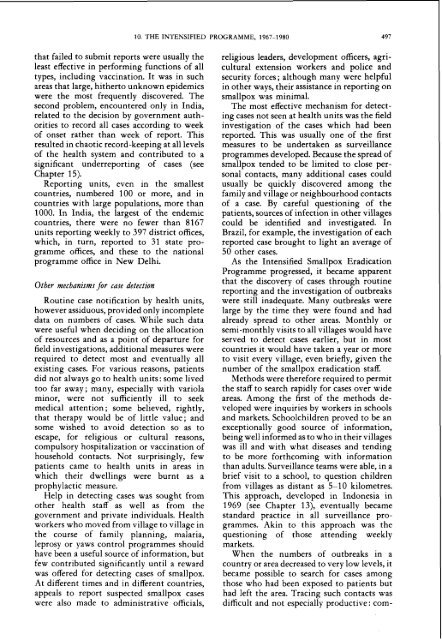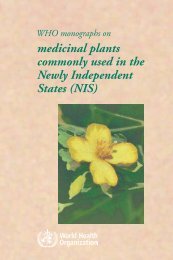smallpox eradication - libdoc.who.int - World Health Organization
smallpox eradication - libdoc.who.int - World Health Organization
smallpox eradication - libdoc.who.int - World Health Organization
You also want an ePaper? Increase the reach of your titles
YUMPU automatically turns print PDFs into web optimized ePapers that Google loves.
10. THE INTENSIFIED PROGRAMME, 1967-1 980 497<br />
that failed to submit reports were usually the<br />
least effective in performing functions of all<br />
types, including vaccination. It was in such<br />
areas that large, hitherto unknown epidemics<br />
were the most frequently discovered. The<br />
second problem, encountered only in India,<br />
related to the decision by government authorities<br />
to record all cases according to week<br />
of onset rather than week of report. This<br />
resulted in chaotic record-keeping at all levels<br />
of the health system and contributed to a<br />
significant underreporting of cases (see<br />
Chapter 15).<br />
Reporting units, even in the smallest<br />
countries, numbered 100 or more, and in<br />
countries with large populations, more than<br />
1000. In India, the largest of the endemic<br />
countries, there were no fewer than 8167<br />
units reporting weekly to 397 district offices,<br />
which, in turn, reported to 31 state programme<br />
offices, and these to the national<br />
programme office in New Delhi.<br />
Other mechanisms for case detection<br />
Routine case notification by health units,<br />
however assiduous, provided only incomplete<br />
data on numbers of cases. While such data<br />
were useful when deciding on the allocation<br />
of resources and as a po<strong>int</strong> of departure for<br />
field investigations, additional measures were<br />
required to detect most and eventually all<br />
existing cases. For various reasons, patients<br />
did not always go to health units: some lived<br />
too far away; many, especially with variola<br />
minor, were not sufficiently ill to seek<br />
medical attention; some believed, rightly,<br />
that therapy would be of little value; and<br />
some wished to avoid detection so as to<br />
escape, for religious or cultural reasons,<br />
compulsory hospitalization or vaccination of<br />
household contacts. Not surprisingly, few<br />
patients came to health units in areas in<br />
which their dwellings were burnt as a<br />
prophylactic measure.<br />
Help in detecting cases was sought from<br />
other health staff as well as from the<br />
government and private individuals. <strong>Health</strong><br />
workers <strong>who</strong> moved from village to village in<br />
the course of family planning, malaria,<br />
leprosy or yaws control programmes should<br />
have been a useful source of information, but<br />
few contributed significantly until a reward<br />
was offered for detecting cases of <strong>smallpox</strong>.<br />
At different times and in different countries,<br />
appeals to report suspected <strong>smallpox</strong> cases<br />
were also made to administrative officials,<br />
religious leaders, development officers, agricultural<br />
extension workers and police and<br />
security forces; although many were helpful<br />
in other ways, their assistance in reporting on<br />
<strong>smallpox</strong> was minimal.<br />
The most effective mechanism for detecting<br />
cases not seen at health units was the field<br />
investigation of the cases which had been<br />
reported. This was usually one of the first<br />
measures to be undertaken as surveillance<br />
programmes developed. Because the spread of<br />
<strong>smallpox</strong> tended to be limited to close personal<br />
contacts, many additional cases could<br />
usually be quickly discovered among the<br />
family and village or neighbourhood contacts<br />
of a case. By careful questioning of the<br />
patients, sources of infection in other villages<br />
could be identified and investigated. In<br />
Brazil, for example, the investigation of each<br />
reported case brought to light an average of<br />
50 other cases.<br />
As the Intensified Smallpox Eradication<br />
Programme progressed, it became apparent<br />
that the discovery of cases through routine<br />
reporting and the investigation of outbreaks<br />
were still inadequate. Many outbreaks were<br />
large by the time they were found and had<br />
already spread to other areas. Monthly or<br />
semi-monthly visits to all villages would have<br />
served to detect cases earlier, but in most<br />
countries it would have taken a year or more<br />
to visit every village, even briefly, given the<br />
number of the <strong>smallpox</strong> <strong>eradication</strong> staff.<br />
Methods were therefore required to permit<br />
the staff to search rapidly for cases over wide<br />
areas. Among the first of the methods developed<br />
were inquiries by workers in schools<br />
and markets. Schoolchildren proved to be an<br />
exceptionally good source of information,<br />
being well informed as to <strong>who</strong> in their villages<br />
was ill and with what diseases and tending<br />
to be more forthcoming with information<br />
than adults. Surveillance teams were able, in a<br />
brief visit to a school, to question children<br />
from villages as distant as 5-10 kilometres.<br />
This approach, developed in Indonesia in<br />
1969 (see Chapter 13), eventually became<br />
standard practice in all surveillance programmes.<br />
Akin to this approach was the<br />
questioning of those attending weekly<br />
markets.<br />
When the numbers of outbreaks in a<br />
country or area decreased to very low levels, it<br />
became possible to search for cases among<br />
those <strong>who</strong> had been exposed to patients but<br />
had left the area. Tracing such contacts was<br />
difficult and not especially productive: com-
















